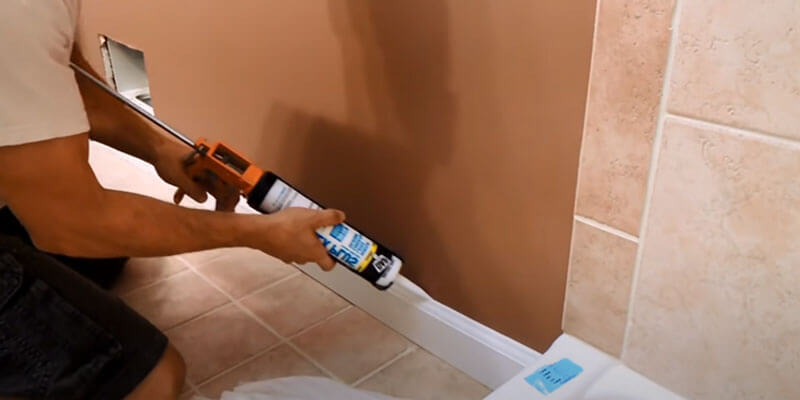Caulk is a sticky element that is used to seal air leaks between building components and materials. But the gap should be a quarter-inch wide. Sometimes it becomes necessary to re-caulk or caulk the bathroom or kitchen area, but who is supposed to do that? Is the landlord responsible for caulking?
In most rental properties, there is confusion over who is responsible for caulking and who is responsible for repairs.
In this article, our expert will suggest to you what the actual matter is. Let’s get started.
Is Landlord Responsible For Caulking: What is The Truth
Caulking is not something that your landlord has to fix, no matter how gross it gets, except if water is leaking and causing water damage.
Shower maintenance and cleaning should be conducted on a regular basis by the owner. However, if the caulking is indeed peeling or becoming dirty, notify your landlord, and they will most likely allow you to replace it by yourself.
Landlords are required to keep their premises up to date in the majority of states. But this covers a wide range of tasks all around the house, so there is not only caulking. As a result, a landlord cannot be held accountable for all of these issues. A renter also needs to cooperate with him.
Water damage or seeping into the bathroom or kitchen may require caulking. If you, as a renter, find the issue, then it is your responsibility. Besides that, whenever a water problem is discovered, a renter has to inform the landlord. After getting permission, the tenant is responsible for solving the leakage issue by applying caulk or sealant.
Here is an overview of those issues that are not the landlord’s maintenance responsibilities towards a house.
Issue 1: Changing Old Bulb
It is a common issue that whenever you move to a new house, you find old bulbs and you need to change them by yourself. Please do not wait for your landlord; it is not his duty.
Issue 2: Batteries That Have Died
Tenants are usually expected to repair any broken items. Even if you can’t make smoke detector batteries die, you’re possibly misusing the relationship between homeowner and renter. Instead of calling, go and replace the battery.
Issue 3: Broken Toilets
You may ask is landlord responsible for broken toilet or not. A blocked pipe, a broken toilet, or a faulty hot water tank can be a constant source of discomfort in the home.
Landlords are generally required by law to make repairs and maintain a rental property. They must follow these requirements when attempting to do any kind of repair on a rental property. But, for any kind of major repair, a landlord is always responsible.
Issue 4: Drywall Hole
Drywall holes look very unprofessional and disturbing, but unfortunately, if you and your kid are responsible for any kind of drywall hole, then fix it on your own. This is something that your landlord is not bound to pay for.
Issue 5: Scratchy Baseboards
The presence of minor scratches on the baseboards is all too common. This is a simple problem to solve. Instead of replacing them, you can use epoxy putty to repair minor dings and dents.
Related: Should You Caulk Between Baseboards And Tile Floor [Proper Discussion]
Issue 6: A Cracked Window Mirror
Your landlord is not required by law to replace a window if someone throws any hard stuff through it. However, you should contact your landlord to inform them of the situation and determine how they want to proceed with the repairs. They’ll probably fix them and ask you to pay them back.
Aside from these issues, infestations of pests, dripping nozzles, broken equipment such as heaters or geysers, or minor plumbing clogs are not the landlord’s responsibility to repair.
What Are Landlords Responsible for Fixing?
The majority of your home’s maintenance is the responsibility of your landlord. Private landlords, authorities, and housing organizations all need to be concerned about this.
So this is the list of landlord responsibilities:
But what about the tenants? As a tenant, fix the minor things by yourself. If your landlord asks you to re-caulk the bathroom, you should keep in mind that caulk does not last indefinitely, but are you really responsible for doing it or not focusing on the issue? Renting a house for a long time demands re-caulking from the renter, but before shifting to a new home, ask the landlord to re-caulk.
The Process of Caulking as A Renter
Caulking is now your responsibility, and your landlord will not assist you, so learn about the process. Rub the old caulk with a putty knife to soften it up and make it easier to remove.
Clean up with paint thinner after removing the cracked old caulk, then apply the fresh caulk. Use it like a toothpaste tube.
Use a “caulk gun” to cut the tip of the gun at a preferable angle. It will give you more control. For a better understanding, use it as a tube of toothpaste. If you want to do it more professionally, practice it on an old piece of plywood or any flat surface.
FAQ
Who is responsible for appliances in a rental property in Florida?
Who is responsible for bathtub caulk replacement?
Can the landlord charge for caulking?
Wrapping Up!
If your bathroom and kitchen caulk is cracking and needs caulking, do not assume the landlord is responsible for caulking? Because he is not going to caulk it. You have to caulk on your own. To solve the issue, use good quality caulk for the bathroom, bathtub, kitchen sink, or backsplash.
Want to Learn More:
- How to Get Rid of Mold in Shower Caulk – Multiple Solution
- Should You Caulk Around Shower Base? (A Proper Guidelines)
- What Type Of Caulk For Crown Molding [5 Types Of Caulk Info]
- How To Prevent Mold In Shower Caulk: 4 Ways Of Prevention
Hello! this is John Cox. If I’m not wrong, you love Home. Right? And you already met one of them who’ve been in this field since 2005 and still go on. According to my interest, I’ve started this blog to share my thoughts about Home sectors, and you’ll love it.


